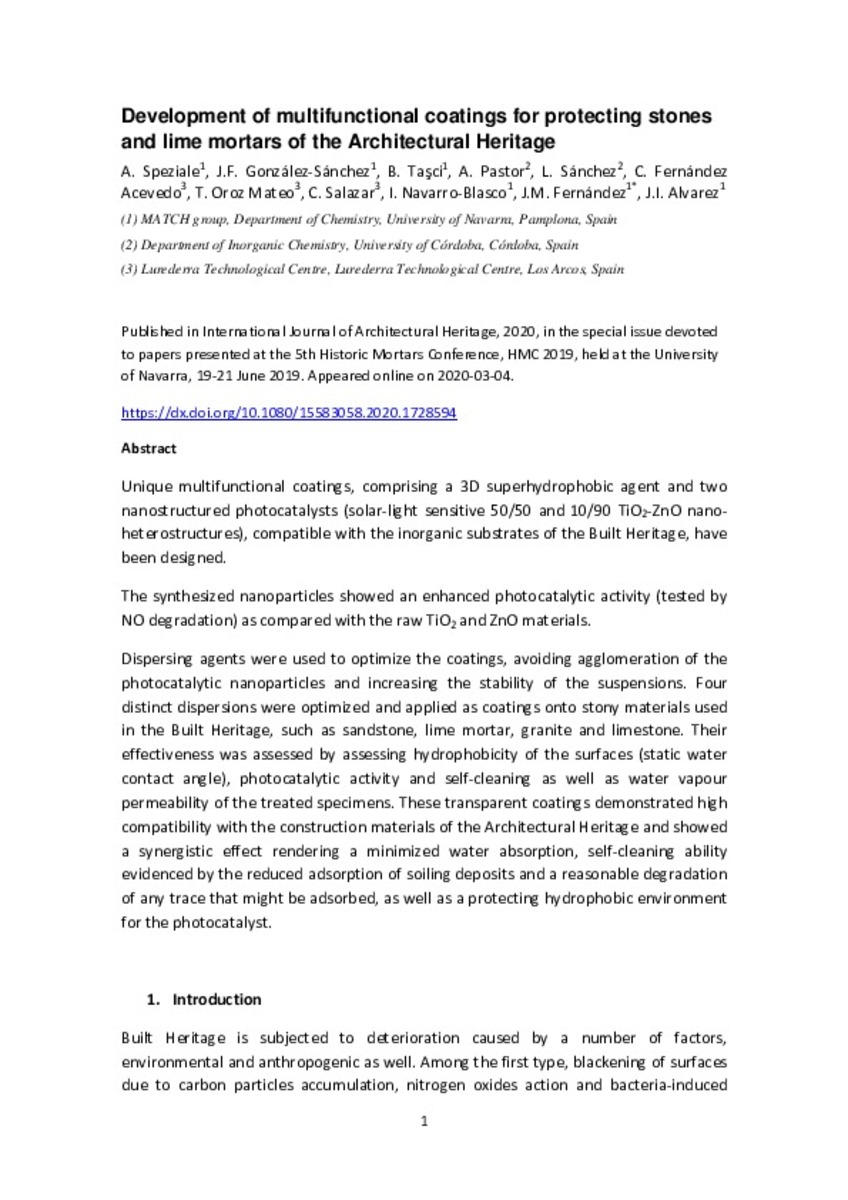Full metadata record
| DC Field | Value | Language |
|---|---|---|
| dc.creator | Speziale, A. (Alessandro) | - |
| dc.creator | Gonzalez-Sanchez, J.F. (Jesús Fidel) | - |
| dc.creator | Tasci, B. (Burcu) | - |
| dc.creator | Pastor, A. (Adrián) | - |
| dc.creator | Sanchez, L. (Luis) | - |
| dc.creator | Fernandez-Acevedo, C. (Claudio) | - |
| dc.creator | Oroz-Mateo, T. (Tania) | - |
| dc.creator | Salaza, C. (Cristina) | - |
| dc.creator | Navarro-Blasco, I. (Iñigo) | - |
| dc.creator | Fernandez-Alvarez, J.M. (José María) | - |
| dc.creator | Alvarez-Galindo, J.I. (José Ignacio) | - |
| dc.date.accessioned | 2020-03-05T09:08:22Z | - |
| dc.date.available | 2020-03-05T09:08:22Z | - |
| dc.date.issued | 2020-03-04 | - |
| dc.identifier.citation | Speziale A, Gonzalez-Sanchez JF, Taşci B, Pastor A, Sanchez L, Fernández Acevedo C, Oroz Mateo T, Salazar C, Navarro-Blasco I, Fernandez JM, Alvarez JI. Development of multifunctional coatings for protecting stones and lime mortars of the Architectural Heritage. Int J Archit Herit 2020; 14(7): pp 1008-1029 | es_ES |
| dc.identifier.issn | 1558-3066 | - |
| dc.identifier.uri | https://hdl.handle.net/10171/58870 | - |
| dc.description.abstract | Unique multifunctional coatings, comprising a 3D superhydrophobic agent and two nanostructured photocatalysts (solar-light sensitive 50/50 and 10/90 TiO2-ZnO nano-heterostructures), compatible with the inorganic substrates of the Built Heritage, have been designed. The synthesized nanoparticles showed an enhanced photocatalytic activity (tested by NO degradation) as compared with the raw TiO2 and ZnO materials. Dispersing agents were used to optimize the coatings, avoiding agglomeration of the photocatalytic nanoparticles and increasing the stability of the suspensions. Four distinct dispersions were optimized and applied as coatings onto stony materials used in the Built Heritage, such as sandstone, lime mortar, granite and limestone. Their effectiveness was assessed by assessing hydrophobicity of the surfaces (static water contact angle), photocatalytic activity and self-cleaning as well as water vapour permeability of the treated specimens. These transparent coatings demonstrated high compatibility with the construction materials of the Architectural Heritage and showed a synergistic effect rendering a minimized water absorption, self-cleaning ability evidenced by the reduced adsorption of soiling deposits and a reasonable degradation of any trace that might be adsorbed, as well as a protecting hydrophobic environment for the photocatalyst. | es_ES |
| dc.description.sponsorship | Spanish Ministry of Economy and Competitiveness MINECO, Spain, under grant MAT2015-70728-P. Government of Navarra under grant number Exp. 0011-1383-2018-000005, project PC065 RECURBAN. Friends of the University of Navarra, Inc.: pre-doctoral grant of J.F. González-Sánchez. | es_ES |
| dc.language.iso | eng | es_ES |
| dc.publisher | Taylor & Francis | es_ES |
| dc.rights | info:eu-repo/semantics/openAccess | es_ES |
| dc.subject | Built Heritage | es_ES |
| dc.subject | Coating | es_ES |
| dc.subject | Granite | es_ES |
| dc.subject | Lime mortar | es_ES |
| dc.subject | Limestone | es_ES |
| dc.subject | Photocatalyst | es_ES |
| dc.subject | Sandstone | es_ES |
| dc.subject | Self cleaning | es_ES |
| dc.subject | Waterproofing | es_ES |
| dc.title | Development of multifunctional coatings for protecting stones and lime mortars of the Architectural Heritage | es_ES |
| dc.type | info:eu-repo/semantics/article | es_ES |
| dc.publisher.place | Philadelphia, PA 19106 | es_ES |
| dc.identifier.doi | https://dx.doi.org/10.1080/15583058.2020.1728594 | es_ES |
| dc.identifier.doi | 10.1080/15583058.2020.1728594 | - |
| dadun.citation.publicationName | International Journal of Architectural Heritage | es_ES |
Files in This Item:
Statistics and impact
Items in Dadun are protected by copyright, with all rights reserved, unless otherwise indicated.






